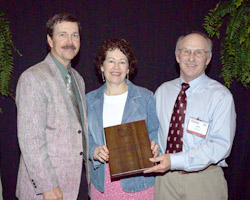Pitchfork Farm Named Commercial Producer of the Year
 The Beef Improvement Federation honored Pitchfork Farm, Stronghurst, Ill., as the 2006 Commercial Producer of the Year during an awards luncheon April 19 at the 2006 BIF Annual Meeting and Research Symposium in Choctaw, Miss. Pictured are (from left) 2005 BIF President Lynn Pelton presenting the award to Sara and Ken Nimrick. |
CHOCTAW, Miss. (April 19, 2006) — The Beef Improvement Federation (BIF) named Pitchfork Farm, Stronghurst, Ill., its 2006 Commercial Producer of the Year during the organization’s 38th annual meeting April 18-21 in Choctaw, Miss.
Owners Ken and Sara Nimrick operate a grain and commercial beef cattle operation consisting of 220 cow-calf pairs and 35 replacement heifers on 340 acres of permanent and rotational pasture. They have been on the same farm in Henderson County since 1971; the land has been in Sara’s family since 1852.
The herd excels in reproductive management through the use of estrus synchronization, artificial insemination (AI) of replacement heifers, and limiting the length of the breeding season for the mature cow herd. Whereas many herds have continued to move their calving dates earlier, the Nimricks calve from late April to late June. This results in a number of heifers and all the cows calving on pasture. Their genetic program for the past 10 years has centered around the use of composite bulls, consisting of 50%-75% Angus or Red Angus and 25%-50% Simmental or Gelbvieh.
The Nimricks were one of the first herds in Illinois to adopt early weaning, weaning at 75-135 days of age in early September. After weaning, calves are backgrounded until mid-winter. Most are sold through a preconditioned feeder calf sale. To monitor feedlot performance and carcass quality, one or two loads of cattle are fed at a commercial lot each year.
The Nimricks continually study their base herd and select sires that will improve traits that are underdeveloped. For the heifers and mature cow herd, they want a trouble-free, low-labor calving season. They feel growth and milk are adequate, so in recent years they have begun to place more emphasis on some of the more subjective traits that are important to their low-input system, such as moderate frame size, body capacity and fleshing ability, thickness, masculinity, mammary structure and disposition. They are also placing more emphasis on carcass EPDs and scan information.
Of exceptional importance to the Nimrick beef cattle operation is to provide the most productive, highest-quality pastures to allow the cow herd to reach its genetic potential. Pasture performance and carrying capacity have increased dramatically with the incorporation of rotational grazing and improved pasture species. In addition, the Nimricks keep complete records on grazing days in each pasture to monitor feed availability and evaluate grass varieties and other pasture management practices.
A unique management practice the Nimricks use to reduce the cost of wintering cows is the grazing of standing corn from January through March. Two items that make this work include the use of strip-grazing, so cows consume approximately 9 pounds (lb.) of corn each day, and supplementation with corn gluten feed three times per week.
Environmental stewardship is emphasized by the Nimricks and consists of utilizing management intensive grazing (MIG), converting much of the cropland into pasture, and installing erosion-control structures where needed. Also, they are in the process of developing natural springs and extending water lines to various areas to eliminate using ponds and streams.
Individuals who have had the opportunity to visit the Nimrick’s farm realize that Ken is extremely knowledgeable about the operation and the overall goals of a successful cow-calf enterprise. He summarizes his goals for the operation in what could be identified as a mission statement: “To maintain reproductive rates while controlling feed and overhead expenses by improving and managing pastures, minimizing machinery and building expenses, utilizing a low-cost wintering program, and grazing as many days of the year as possible.”
Ken is known as Dr. Nimrick to his students at Western Illinois University, where he serves as beef cattle professor in the ag department. Since Ken is gone a number of days, assistance is provided by the Nimricks’ daughter and son-in-law, Kristin and Alan Durkee of Stronghurst. This help allows him to share his many years of practical experience and expertise with future producers and leaders of the Illinois beef cattle industry.
BIF was formed as a means to standardize programs and methodology and to create greater awareness, acceptance and usage of beef cattle performance concepts. More information can be found on the organization’s Web site, www.beefimprovement.org.